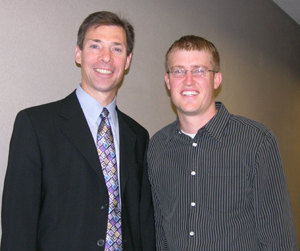 |
Kyle Meyer, Ph.D., associate dean for the School of Allied Health Professions, with Aaron Wenburg, a member of the SAHP PT Class of 2002 who works at Hastings Physical Therapy. |
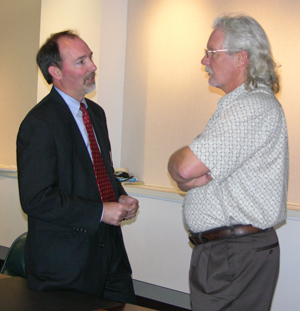 |
Darwin Brown, clinical education coordinator in the School of Allied Health Professions Physician Assistant (PA) program, talks with Jon Becker, who is a PA in Minden. Becker is a 1993 graduate of the UNMC PA program. |
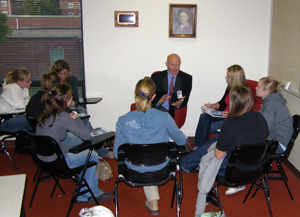 |
Jim Temme, associate director of SAHP radiation science technology education, discusses his program’s admission requirements and other topics with undergraduate students at the University of Nebraska at Kearney. |
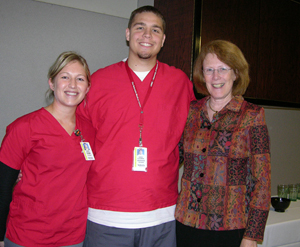 |
UNMC clinical laboratory science students Olivia Beethe and Derek Pohlmann with Linda Fell at a community gathering at Hastings Mary Lanning Memorial Hospital, where the two students are doing clinical rotations. |
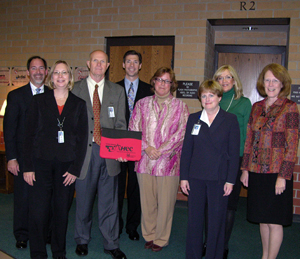 |
Darwin Brown, Diane Landon, Jim Temme, Kyle Meyer, Ph.D., Sarah Cunningham, Pat Hageman, Ph.D., Sally Husen and Linda Fell at the Grand Island Area Health Education Center (AHEC). The allied health team met with high school students and their parents at AHECs in Grand Island and Norfolk. |
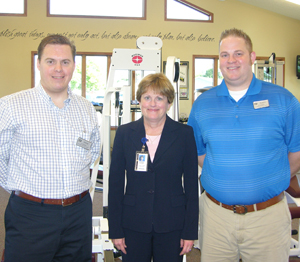 |
Pat Hageman, Ph.D., with Steve Line, left, and Rusty Kuhl at Columbus Physical Therapy. Line is a 1997 UNMC PT graduate. |
How about hitting the road?
So recently, Dr. Meyer and leaders from the school headed out for a four-day, six-city tour of central and northeast Nebraska that included stops in Kearney, Hastings, Grand Island, Columbus, Norfolk and Wayne. The team visited with about 350 people at the various stops.
“We had several goals with this trip,” Dr. Meyer said. “We wanted to raise awareness about allied health professions and the school, we wanted to thank preceptors and alumni around the state, we wanted to meet potential students and we wanted to hear from the local communities to see how we can help meet their allied health workforce needs.”
Raising awareness about allied health presents quite the challenge. As trip participant Pat Hageman, Ph.D., said, “People come to UNMC to be a nurse, doctor, etc. No one comes to be an ‘allied healther.’ ”
That’s because allied health is a blanket term for about 200 health care professions such as physical therapists, physician assistants, radiographers and nuclear medicine technologists.
During many stops on the trip, Dr. Meyer would respond to the question “what is allied health?” as such, “Most people can typically identify the four major health professions – doctor, nurse, dentist and pharmacist. Well, we’re everybody else.”
And “everybody else” composes about 60 percent of the health care workforce, Dr. Meyer said.
Throughout the trip, whether at community hospital gatherings, meetings with potential students or in talking with members of the media, Dr. Meyer and the SAHP contingent stressed the various educational programs that are available through UNMC’s School of Allied Health Professions.
With the school now united under one roof in Bennett Hall, and a shortage of health care workers, including many in the allied health professions, Dr. Meyer said the time is right for the school to take on a more visible presence on and off campus.
“We believe we can offer many people, both new and non-traditional students, career options that maybe they haven’t thought of before, options that may suit them very well,” Dr. Meyer said.
University of Nebraska at Kearney freshmen Ashley Korth and Jessica Jasnoch used a meeting with the SAHP leaders at UNK to explore UNMC’s physical therapy program with Dr. Hageman.
After a small group meeting with the former director of the PT program, Korth and Jasnoch both said they knew more about the profession and about what they need to do to pursue such a career.
“Thanks to this meeting I know more about what I need to do to prepare to apply for UNMC’s program,” Korth said, “and I know some of the steps I can start taking now.”
Matt Gotschall, president of Central Community College-Columbus, said UNMC does a great job cooperating with his school to get people started on their paths toward allied health careers.
“Central Community College-Columbus Campus is extremely pleased with the outstanding partnerships and proactive solutions that UNMC is taking to make allied health education available to our transfer students,” Gotschall said. “We greatly appreciate the allied health school taking the time and effort to visit our facilities and partner with us in serving more Nebraskans.”
|
|
“These visits give us a chance to say thanks to the preceptors for all the work they do in helping us educate the students,” said Jim Temme, associate director of the radiation science technology program. “It also lets us hear from them about their needs and about how we may help them.”
“We work with the laboratories, instructors and students on a daily basis, but often the hospital administration and community leaders are not aware of their laboratories’ contributions to education at UNMC,” said Linda Fell, director of the Clinical Laboratory Science (CLS) program.
A recurring theme during the trip was the shortage of health care workers.
“I was about to hop into a room and start seeing patients,” Dr. Hageman said after a visit to a very busy Kearney PT clinic.
Lee Elliot, vice president for human resources and fund development at Saint Francis Medical Center in Grand Island, said he was gratified to see the SAHP taking steps to address the shortage.
“All of us that work in hospital human resources are seeing the shortages develop. … The implications for viability of hospitals, quality of worklife for those who work in health care and the quality of care provided to our patients are dramatic,” Elliot said. “It is reassuring that UNMC is working to address these shortages in those areas in which they provide education and training.”
As the school moves forward, addressing the shortage of health care workers will be one of its main concerns.
“As is the case with all health professions, there are glaring shortages in allied health in Nebraska,” Dr. Meyer said. “This trip really helped us see and hear what the needs are in terms of allied health across Nebraska. Now we will take what we learned and look at how we can help meet these needs.”